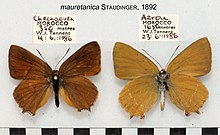Satyrium esculi
| Satyrium esculi | ||||||||||||
|---|---|---|---|---|---|---|---|---|---|---|---|---|

Satyrium esculi |
||||||||||||
| Systematics | ||||||||||||
|
||||||||||||
| Scientific name | ||||||||||||
| Satyrium esculi | ||||||||||||
| ( Huebner , 1804) |
Satyrium esculi is a butterfly from the family of Gossamer (Lycaenidae).
features
The wingspan of the moth is 30–34 mm. The brownish moths have a characteristic pattern of orange-black spots and white-black lines on the underside of the hind wings.
Similar species
distribution
Satyrium esculi is common in the western Mediterranean and on the Iberian Peninsula . It is only missing in Galicia on the Iberian Peninsula . In the north, the occurrence extends from the Pyrenees across southern France to Liguria in Italy. The species is also found in the Balearic Islands . In North Africa their occurrence ranges from Morocco to Tunisia.
Way of life
Satyrium esculi usually forms two generations per year. The moths fly from late May to July. They are often seen on Mediterranean blackberry bushes ( Rubus ulmifolius ). The forage plants of the caterpillars include the holm oak ( Quercus ilex ) and Kermes oak ( Quercus coccifera ). The caterpillars are defended by horse ants (genus Camponotus ), which in return supply them with sugary secretions. The species overwinters as an egg or as a caterpillar on branches and trunks.
Taxonomy
At least two subspecies are distinguished:
- Satyrium esculi esculi ( Huebner , 1804) - Iberian Peninsula, southern France
- Satyrium esculi mauretanica ( Staudinger , 1892) - Algeria, Morocco
The following synonyms can be found in the literature :
- Nordmannia esculi ( Huebner , 1804)
- Papilio esculi Hübner , 1804 - original combination of names
- Strymon esculi ( Huebner , 1804)
- Thecla esculi Huebner , 1804
Individual evidence
- ↑ a b c Satyrium esculi in Fauna Europaea. Retrieved July 17, 2018
- ↑ a b c Satyrium esculi . www.biolib.cz. Retrieved July 17, 2018.
Web links
- Satyrium esculi at Lepiforum eV
- Satyrium esculi at www.pyrgus.de
- Querquera - Satyricum esculi at biocostagranadinafauna.blogspot.com

